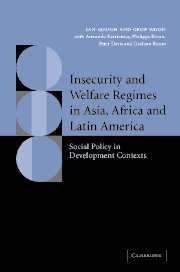 Insecurity and Welfare Regimes in Asia, Africa and Latin America
Insecurity and Welfare Regimes in Asia, Africa and Latin America Published online by Cambridge University Press: 04 August 2010
Introduction
Benedict Anderson identifies a common post-war pattern of development in the ‘long strip of coastal capitalist states stretching down from South Korea to the eastern edge of the Indian Ocean’ (Anderson 1998: 300). This definition of East Asia excludes the two regional powers, Japan and China, alongside North Korea. It embraces ASEAN, the Association of Southeast Asian Nations, but leaves Myanmar in limbo, and extends northwards to include South Korea, Taiwan and Hong Kong. The major countries are shown in table 5.1, in order of economic affluence. All the countries, except Thailand, were colonised up to and including the twentieth century but by a variety of different powers: Portugal, Spain, the Netherlands, France, Britain, the US and Japan. The region also encompasses vast differences, from rich Singapore to very poor Laos and Cambodia – country variations wider than those in any other part of the world. To make our task manageable, this chapter will ignore the richest – the city-states of Singapore and Hong Kong – and the poorest – the newly emerging economies of Vietnam, Cambodia and Laos. The remaining group are all classified by the World Bank as ‘middle income’, though Indonesia hovers on the borderline of low-income countries.
Within this group, I concentrate on five countries: Indonesia, South Korea, Malaysia, the Philippines and Thailand. These are of interest for three reasons. They have all been participants in the ‘East Asian miracle’ and beneficiaries of the alleged benefits of economic openness and market-friendly policies (World Bank 1993).
To save this book to your Kindle, first ensure [email protected] is added to your Approved Personal Document E-mail List under your Personal Document Settings on the Manage Your Content and Devices page of your Amazon account. Then enter the ‘name’ part of your Kindle email address below. Find out more about saving to your Kindle.
Note you can select to save to either the @free.kindle.com or @kindle.com variations. ‘@free.kindle.com’ emails are free but can only be saved to your device when it is connected to wi-fi. ‘@kindle.com’ emails can be delivered even when you are not connected to wi-fi, but note that service fees apply.
Find out more about the Kindle Personal Document Service.
To save content items to your account, please confirm that you agree to abide by our usage policies. If this is the first time you use this feature, you will be asked to authorise Cambridge Core to connect with your account. Find out more about saving content to Dropbox.
To save content items to your account, please confirm that you agree to abide by our usage policies. If this is the first time you use this feature, you will be asked to authorise Cambridge Core to connect with your account. Find out more about saving content to Google Drive.